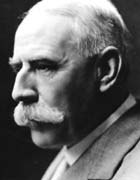2007 European Brass Band Championships - Test piece review
30-Apr-20074BR looks at Martin Ellerby's 'Elgar Variations' and tries to find just who his 'friend pictured within' really is...
 In 1900 Edward Elgar premiered his ‘Dream of Gerontius' in Birmingham to widespread acclaim. 107 years later, Martin Ellerby pays tribute to possibly the greatest composer of his generation with the premiere of his own work ‘Elgar Variations'. It should be greeted with the same amount of popular appreciation too, for it is a wonderfully realised work of musical intellect and insight.
In 1900 Edward Elgar premiered his ‘Dream of Gerontius' in Birmingham to widespread acclaim. 107 years later, Martin Ellerby pays tribute to possibly the greatest composer of his generation with the premiere of his own work ‘Elgar Variations'. It should be greeted with the same amount of popular appreciation too, for it is a wonderfully realised work of musical intellect and insight.
2007 is the 150th anniversary of Elgar's birth (although it is also the 150th anniversary of Dmitri Mendeleyev who gave us the Periodic Table too – but that would have been a musical step too far perhaps) and Martin Ellerby thought it appropriate therefore to mark the occasion with a piece in honour of the most quintessential English composer of all time. Nobody so embodies the virtues as well as the repressions of late Victorian/early Edwardian life than he.
Elgar represented an England where half the globe was Empire pink in colour, Britain had ‘Dominions' to rule over, men wore starch collars and luxuriant moustachioed upper lips and women had yet to have gained the evangelical glint in their eye of emancipation and suffrage. When Elgar was at his musical peak, Britain had just tipped over the own summit of its industrial, political and economic powers - it was the beginning of the dog days of British Imperialism on the grandest of scales.
That was reflected very much in Elgar's music – tension and repression abound, the sense of ‘noblesse oblige' permeates the miasma. Passions and emotions are disturbing undercurrents, enjoyed in private, hidden in public, everything has its place in an ordered and cultured society: ‘Pomp & Circumstance' summed it up perfectly. Martin Ellerby gloriously brings it all back to life once again with this wonderful composition.
This is not however a pastiche of Elgar's greatest hits, although even to the untrained ear the influences of his most famous compositions abound – although strangely perhaps, not ‘Gerontious'.
 The composer is at pains to stress that there are many illusions to the music of Elgar without recourse to blatant pastiche. He believes it may help to think of the work as a series of songs and dances, although to be fair, that may be hard in places. What really characterises the work is the composer's ability to enable the music to be moulded and shaped into an Elgarian form by the conductors and performers themselves. Overcook it and it indeed becomes pastiche, but not by the composer – by the performers. It is a tightrope of the thinnest high wire writing, so cleverly spanning the entire piece from the first to the last bar.
The composer is at pains to stress that there are many illusions to the music of Elgar without recourse to blatant pastiche. He believes it may help to think of the work as a series of songs and dances, although to be fair, that may be hard in places. What really characterises the work is the composer's ability to enable the music to be moulded and shaped into an Elgarian form by the conductors and performers themselves. Overcook it and it indeed becomes pastiche, but not by the composer – by the performers. It is a tightrope of the thinnest high wire writing, so cleverly spanning the entire piece from the first to the last bar.
In his notes to accompany the piece, Ellerby gives the conductors the musical rope either to hoist themselves up high or to strangle themselves to death with: "I have deliberately kept things to a minimum (talking of tempo and markings) as the true test here is to find the style and interpret that aspect over the whole structure." This places the musical ball right in the conductors court now doesn't it, especially as a little later he implicitly states ‘…the emotional core of the piece requires a passionate but not saccharine approach to pacing and sensuality."
Elgar no doubt liked a bit of slap and tickle, but never slushy sentimentality. Expression and emotion are asked for, but ‘Lassie Come Home' tears and bucolic Pears Soap kids with big eyes and chocolate box smiles are not. A slight dusting of tasteful emotional coating will bring all the beauty of Elgar and Ellerby to the fore; dip it in a double cream, extra fudge spread, heart on sleeve chocolate slush, and you will just make yourself sick with the richness of it all. As Ellerby writes "This is for the conductors to discover… and I encourage them to do so."
Some conductors will of course go further than others, but the composer has also laid a number of very clever and cunning traps too – the hardest of which is to try and allow the music to be paced correctly throughout the eight variations. These themselves are linked continuously rather than played with defined breaks and so the ability to ensure seamless transition in tempo is crucial. It is lovely writing.
Dynamically too the work allows for subtlety rather than ‘crash bang wallop what a picture' pyrotechnic effects. This is writing that reflects rather than copies its inspiration and the markings allow for well defined levels of dynamic strata to be realised in full. The Edwardians had the same repulsion of harshness as they did for the lower classes who voted Labour, and Elgar was the same. There is strength and even brittleness to be found in the score, but never common debauched rudeness. There are not too many fortissimos let alone fff.
The Elgar ‘fingerprints' so to speak can be clearly identified, although Martin Ellerby has intelligently placed them to lead you to, rather than to immediately reveal the ‘enigma' within. Snippets and motifs from the ‘Enigma Variations' appear regularly, as does the trademarks sweeping sevenths and the clever use of tension in building musical lines that then subside and rise again. Even Elgar's name can be heard towards the end just in case you didn't quite catch where the inspiration comes from, whilst there are also little subtle nods and winks to his other works such as ‘Chanson de Matin' and ‘Pomp and Circumstance', although it is the various little quotes from the various ‘friends pictured within' and ‘Enigma' that are most strongly felt.
The cornet and euphonium players take the brunt of the action in solo terms, but there is also plenty of wonderful ensemble interplay too (as well as some neat little motif work for solo instruments too – especially the timp players). Each of the variations has its own character and form, with the ‘emotional core' as Ellerby describes it coming late in the piece and which will surely prove the crux of the whole work. This requires a degree of subtle finesse in execution that only the very best bands and the best players can provide. The leading lines are marked ‘molto espressivo' – but remember the need to keep a lid on the ‘Kleenex tissue' stuff. This will really take some playing to remain Elgarian.
It all ends in splendid ‘Last Night of the Proms' fashion although not quite as ‘flag waving, two fingers up to Johnny Foreigner' as you get at that gormless event. This is noble, refined and waspishly sharp. It may appear to be heading one way, but just as quickly finishes off the other.
As for the ‘enigma' from Ellerby himself? Who knows, but there are clues if you dig around a bit and a couple of witty little phrases that may just give the game away if you are the type of person who can finish the Times crossword in 15 minutes and who would have wanted to work at Bletchley Park during the War. If you can work it out then it will only add to the enjoyment of a very fine work for brass.
Iwan Fox.















